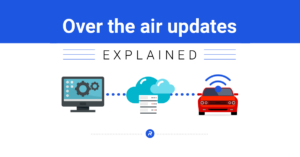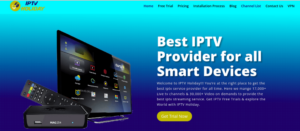Video on demand, or VOD, refers to digital video services that allow users to stream or download movies, TV shows, and other video content on-demand via the internet.
VOD delivers media directly from a provider’s servers to the viewer’s device, without requiring a traditional cable or satellite subscription. There are a few main types of VOD services available to consumers today.
VOD services have upended the home entertainment landscape, providing convenient access to vast libraries of content with just the click of a button.
Streaming video has become a dominant form of media consumption, with VOD services continuing to grow their subscriber bases globally each year.

When Did Video on Demand Start? – A Brief History
The first video-on-demand (VOD) systems started in the early 1990s as pay-per-view services through cable and satellite providers. These allowed viewers to order individual movies, events, and adult content for a fee.
In the late 1990s, digital video recorders like TiVo brought VOD into people’s homes by allowing them to save shows to watch later on.
In the 2000s, cable companies started offering VOD libraries for cable subscribers to access at any time. These were limited libraries focused on recent content.
Subscription VOD services like Netflix introduced affordable unlimited on-demand libraries. Netflix started as a DVD-by-mail service in 1999 before pioneering streaming in 2007.
Today, numerous subscription VOD services like Hulu, Prime Video, Disney+, HBO Max, and more offer extensive libraries of TV shows, movies, originals, and live content.
Video on Demand vs. Live Streaming
Video on demand allows you to watch video content when you want. Live streaming requires you to tune in at a scheduled time to watch. VOD has pause, rewind, and fast-forward capability. Live streaming does not.
VOD allows you to build a library and watch repeatedly. Live streaming is a one-time broadcast. Live streaming offers a sense of community for live events. VOD is more individualized.
VOD requires video files to be uploaded ahead of time. Live streaming is in real-time as it happens. Many services like Hulu offer both extensive VOD libraries as well as options for live streams.
Video on Demand vs. OTT
VOD stands for video on demand. OTT stands for over-the-top. VOD is the technology that allows viewers to access video content on-demand. OTT is the delivery method that transports this content over the internet.
OTT platforms like Netflix and Hulu use VOD technology to deliver on-demand shows, movies, and originals through apps over the internet.
OTT bypasses cable, satellite, and traditional media distribution to go “over-the-top” and deliver directly to viewers through the internet. This makes worldwide distribution possible.
All major VOD services like Netflix and Prime Video are delivered over the top through internet streaming. So OTT enables the VOD technology.

Video on Demand vs. Pay-Per-View
Pay-per-view was the early model of VOD in the 1990s that let viewers order individual movies, events, or adult programming on-demand through their cable or satellite provider for a per-view fee.
Modern subscription VOD services like Netflix and Hulu give you unlimited on-demand access to huge libraries of content for a flat monthly fee. Pay-per-view uses an à la carte model while subscription VOD offers a flat-rate all-you-can-watch model.
Pay-per-view VOD was limited to more recent releases while subscription VOD offers extensive libraries going back decades.
Modern subscription services have mostly replaced pay-per-view VOD, but some live events like boxing matches still offer a pay-per-view option.
Video on Demand Statistics
80% of U.S. households now use a subscription VOD service like Netflix, Hulu, or Prime Video. (Leichtman Research Group) Netflix has over 220 million subscribers worldwide as of Q1 2022.
(Netflix) The average Netflix subscriber spends 10 hours per week watching content on the platform. (Wall Street Journal) 77% of Netflix viewing comes from its back catalog greater than a year old.
(CNBC) 43% of Netflix subscribers pay between $11-$15 per month while only 5% pay over $20 per month. (Statista) 72% of OTT viewing on platforms like Netflix happens via connected TV devices. 28% comes from mobile. (Conviva)
Types of VOD Services
There are a few major categories of video-on-demand services:
SVOD
SVOD stands for subscription video on demand. With SVOD services, users pay a recurring monthly or annual fee to gain unlimited, on-demand access to a library of content.
Leading examples of popular SVOD services include Netflix, Hulu, Amazon Prime Video, Disney+, HBO Max, and many more.
SVOD services allow subscribers to enjoy as much on-demand video streaming as they want, making them ideal for binge-watching full seasons of shows.
The subscription fee gives access to the service’s entire catalog of licensed and original programming.
TVOD
TVOD stands for transactional video on demand. With TVOD services, users pay a one-time fee to stream or download a specific piece of video content for a limited duration.
TVOD services include Google Play, iTunes, YouTube Movies, Amazon Instant Video, and more.
The transactional model gives users more flexibility if they just want to watch a single movie or TV episode. Rates are usually between $1-$5 per video. After the rental period, access to the video expires unless it is purchased outright digitally.
AVOD
AVOD stands for ad-supported video on demand. As the name suggests, AVOD services offer free access to stream movies and shows, but with periodic advertisements interrupting the content.
Hulu, Tubi, Crackle, and Peacock are examples of leading AVOD platforms.
The ad breaks represent the tradeoff users make to gain free access. However, AVOD services tend to offer a lighter ad load than traditional TV.
They also have expansive content libraries, making them popular among cost-conscious streamers.
FVOD
FVOD refers to free video-on-demand services that offer select movies and shows to users at no charge. FVOD services generate revenue from the advertisements displayed before the videos begin.
Examples include The Roku Channel, Pluto TV, and IMDb TV, among others.
FVOD services provide a free alternative to paid services but have a more limited catalog. The quality of free content can also vary.
But FVOD fills a niche for budget-minded streamers who still want choice.

How VOD Streaming Works
The technical mechanics behind streaming VOD content are quite complex, but break down into a few key phases.
First, the VOD service organizes information about its media assets into structured metadata that powers its content database and catalogs.
Next, the source media is encoded into multiple digital formats like H.264 video to enable adaptive streaming across devices and network conditions.
After that, the encoded video and audio are packaged into segments along with metadata to power the playback experience.
Then, the packaged content is loaded onto the VOD provider’s content delivery network, a system of distributed servers delivering media globally.
During playback, when a user makes a request, the associated video segments are delivered from the CDN servers closest to the viewer for smooth streaming.
Finally, VOD platforms use data analytics to monitor streaming metrics, quality of experience, and watch patterns to optimize their systems and catalog.
From an end-user perspective, this complex back-end technology enables seamless on-demand viewing and downloading of digital video to virtually any internet-connected device.
User Experience of VOD
From the consumer standpoint, VOD platforms aim to provide intuitive access and viewing of video content libraries. While experiences vary across services, some common features define the core VOD user experience:
- Sign Up and Login – Users create an account with the VOD provider to gain access. For SVOD, this involves entering payment details.
- Content Discovery – Services offer search, personalized recommendations, and human-curated sections to discover content.
- Watchlists and Bookmarks – Users can bookmark titles of interest and create organized watchlists of content to view later.
- Profiles – Many services allow personalized user profiles for each member of a household, along with parental controls.
- Streaming Playback – Users can instantly play videos on-demand with pause, seek, closed captions, and adjustable video quality.
- Downloads – Select titles are available for download to mobile devices for offline, on-the-go playback without an internet connection.
- Ratings and Reviews – Users can rate titles and read reviews submitted by other viewers to discover popular and relevant content.
- Multi-Device Access – Services support user access across mobile devices, smart TVs, gaming consoles, streaming media boxes, web browsers, and more.
VOD Industry Trends
Some important current trends that are shaping the VOD streaming industry include the proliferation of streaming devices like Roku, Fire TV, and Apple TV which are expanding access to streaming video.
There has also been a rise of free, ad-supported VOD services offering budget-conscious consumers an alternative to paid services.
Additionally, traditional media companies are launching their streaming services, fragmenting content libraries across multiple platforms.
Declining cable and satellite subscriptions show consumers shifting to more affordable and flexible VOD options. Streaming platforms are invest heavily in exclusive original programming to differentiate themselves in a crowded market.
Leveraging big data and AI helps better personalize, promote, and target content to viewers based on taste. Support for 4K Ultra HD and HDR is creating a premium streaming experience for home theaters.
Challenges like bandwidth costs, content rights, and account sharing affecting industry profit margins need to be addressed.
Expanding internationally with localized content catalogs and pricing plans tailored for overseas markets is another focus area. Interactive content like choose-your-own-adventure specials provides new forms of viewer engagement.
The Future of VOD Streaming
VOD streaming still appears to have significant room for continued growth. In the future, we may see more streaming services consolidating or exiting the market, leaving a few dominant players.
Live sports and events streaming could become commonplace across VOD platforms.
Virtual reality and 360-degree video may be integrated into select streaming apps and titles. Targeted ads during streamed content based on viewer data analytics are likely to emerge.
Downloads and offline viewing support for the majority of VOD content libraries could become standard. Low-latency streaming may enable synchronous virtual co-viewing experiences. Cloud gaming-on-demand tied into VOD platform ecosystems could grow.
Compression and video encoding innovations may enable 8K streaming over broadband. Social features merged into streaming apps could make VOD more interactive.
Voice control and AI assistants may enhance content search and discovery. As the industry evolves, these are some of the possible developments we may see in the future as VOD streaming continues to grow.

Frequently Asked Questions (FAQ)
Q1. What is the difference between streaming and downloading video?
Ans. Streaming starts playing video content from the internet in real time without needing to download the full video file first. Downloading transfers the complete video file before viewing.
Q2. Does streaming video use a lot of data?
Ans. Streaming can use substantial data based on video quality. HD video consumes up to 3GB per hour. Playback options capped at lower resolutions can reduce data usage.
Q3. Can I find pirated movies on VOD services?
Ans. No, VOD services legally license content. Uploading or viewing pirated videos goes against their terms of service. Users should avoid piracy and support creators through authorized platforms.
Q4. What internet speed do I need for streaming?
Ans. For HD streaming with minimal buffering, an internet connection providing at least 5 Mbps speed is recommended. Higher quality 4K streaming requires 25 Mbps or more for the best performance.
Q5. How do ads work on ad-supported VOD services?
Ans. Ads appear at intervals during the video playback, either pre-roll before the content or mid-roll between scenes. Ad frequency varies based on the content length and provider policies. Users can’t skip ads.



